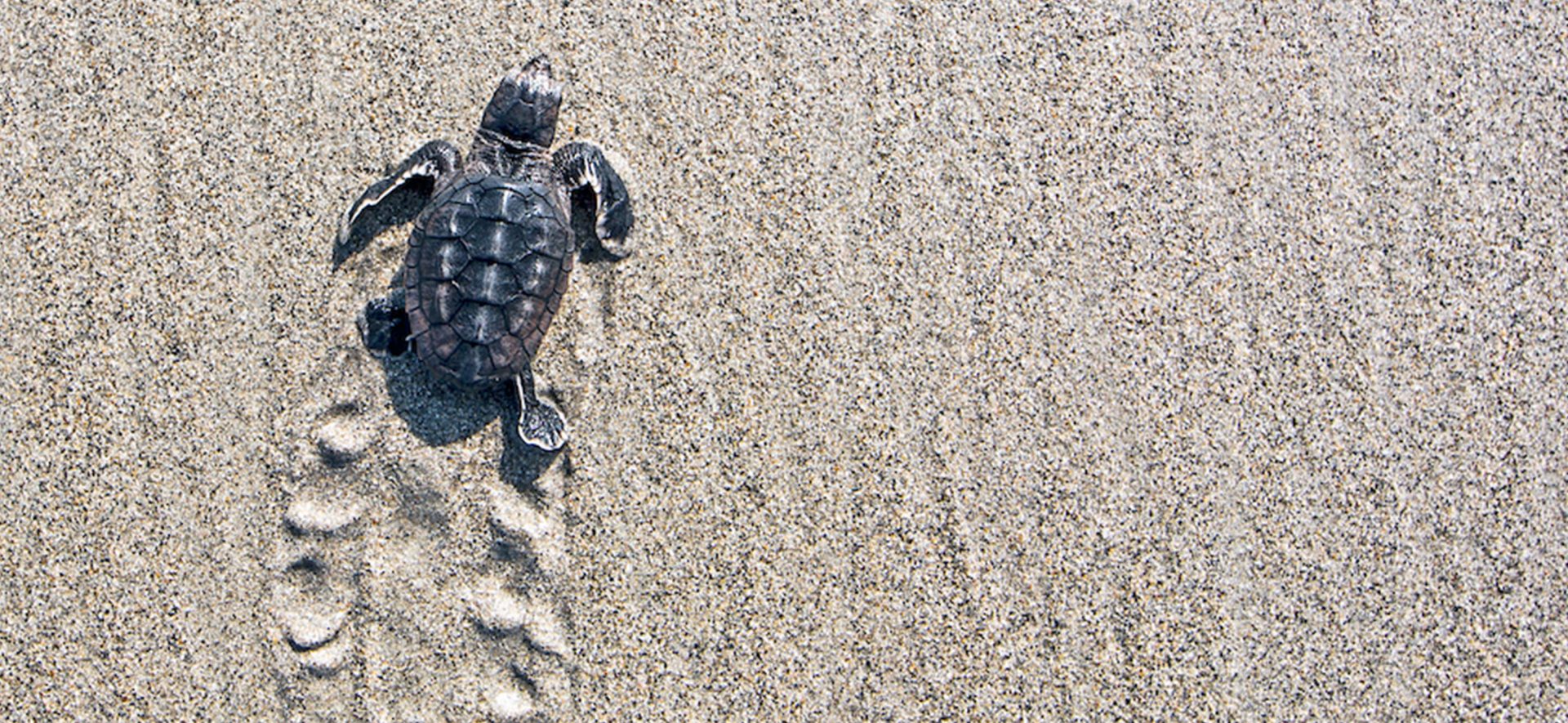As the sun rises over Sunny Isles Beach, you’ll see the beginnings of a perfect Miami day by the ocean — seabirds calling, waves softly crashing, and the signature red umbrellas of Acqualina Resort & Spa being set up for the blissful hours ahead. You may also spot the Miami-Dade County Sea Turtle Conservation Program as they conduct their daily survey, looking for signs of new sea turtle nests and monitoring existing ones to see if, perhaps, its little ones have hatched overnight.
Officially from May 1st to October 31st, it’s sea turtle season in Miami-Dade County, which welcomes a wondrous spectacle of sea turtles scrambling out of their nests to find new homes in the Atlantic. And sometimes, the season begins even earlier: “This year, we started [surveying] Sunny Isles [Beach] in March, and thankfully we did because we had a leatherback sea turtle nest there on March 31st!” says Teal Kawana, project manager and permit holder for the Sea Turtle Conservation Program.
During each season, Miami sees about 600 nests — and numbers are increasing, adds Colette Biondi, assistant manager for the Sea Turtle Conservation Program.
Few are lucky enough to see the turtles make their way to the ocean by chance, since it doesn’t occur in the daylight. However, guests at Acqualina Resort & Spa will have the rare opportunity to watch two private sea turtle hatchling releases this summer.

The purpose of the event isn’t just to witness an awe-inspiring (and, well, “aww”-inspiring) natural phenomenon. “It’s [also] a really good opportunity for [Acqualina] residents and guests to come and learn about turtles and be more aware of our conservation efforts and what’s happening on the beach, and then hopefully spread their knowledge to other people as well,” explains Biondi.
From sand to sea, the experience offers a glimpse into the fascinating life cycle of sea turtles. It all begins overnight, when the mother sea turtle will crawl up onto the beach to find a place to nest. If she’s unsatisfied with her chosen spot, she’ll go back to the ocean and try again another night, known as a false crawl — or, if she decides it’s the perfect place, she’ll lay her nest and return to the ocean.
The next morning, the Sea Turtle Conservation Program will begin their aforementioned survey a half-hour before sunrise, taking data on existing nests and looking for new ones (as well as false crawls) across 18 miles of beaches throughout the county, safely marking them off with tape to keep them from being disturbed. And anywhere from 45 to 80 days later, those baby sea turtles are ready to enter the world above.
With a tiny tooth in the front of their mouth, all of the turtles in the nest chew a little crack in their eggs at the same time. “When they are all hatching, the sand falls down into the chamber of the nest as they’re climbing up, and it kind of ‘elevators’ them up to the top [as they dig],” says Biondi. “When you see them coming out it’s called a ‘boil,’ because it looks like the sand is bubbling water.”

Using the reflection of the moon on the water as a beacon, they crawl across the sand and into the ocean and enter a “swimming frenzy.” They’ll swim until they reach the Sargasso Sea, an area of seaweed in the Atlantic that keeps them safely camouflaged. “They’ll live there and hide until they’re big and strong enough to get out there and explore out on their own,” says Biondi. They’re fully matured adults around age 20, and when it comes time for them to become mothers themselves, they return to the very same beach where they were hatched to lay their nests, repeating the cycle.
Sometimes, a few of the hatchlings won’t make it out of the nest with the other baby turtles — this is where the Sea Turtle Conservation Program comes in again. After it’s hatched, they’ll occasionally excavate a nest. “We’ll take all of our data [as usual], and three days later we’ll come back and dig up all the nest contents and take an inventory of what’s in there,” shares Biondi. If there are any babies stuck, they set them into the ocean during a hatchling release, such as the private ones they’ll host for Acqualina this summer.
As a guest or resident, you can experience an exclusive hatchling release beginning at 7pm on Wednesday, July 24th and Wednesday, August 7th. After making an advance reservation with the concierge, you’ll receive round-trip transportation to Haulover Beach Park, where the releases take place. The event starts with an engaging presentation about the lives (and threats) of sea turtles, as well as the work that the Sea Turtle Conservation Program does (including their daily surveys and responding to sea turtle strandings). After 9pm when the night sky is dark, the hatchlings are released, illuminated by red turtle-friendly lighting that won’t confuse them on their journey.

By the end of the evening, the babies will be making their way out into the ocean — and you’ll have collected an unforgettable, once-in-a-lifetime experience alongside the sea turtles of South Florida.
—
Before your sea turtle hatchling experience, you’re invited to explore Acqualina’s FUN Room. Featuring splashes of vibrant color, creative props, a giant ice cream mural, animated backdrops of balloons and bubbles, and much more, it’s the perfect place to let your imagination run free while capturing made-for-Instagram memories with your loved ones.
Photos courtesy of the Sea Turtle Conservation Program. All work with sea turtles in Miami-Dade is conducted by authorized personnel under FWC permit – MTP-19-017. Learn more about the Sea Turtle Conservation Program on their Facebook page.

